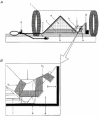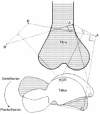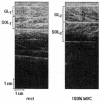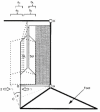Changes in Achilles tendon moment arm from rest to maximum isometric plantarflexion: in vivo observations in man
- PMID: 9660906
- PMCID: PMC2231068
- DOI: 10.1111/j.1469-7793.1998.977bj.x
Changes in Achilles tendon moment arm from rest to maximum isometric plantarflexion: in vivo observations in man
Abstract
1. The purpose of the present study was to examine the effect of a plantarflexor maximum voluntary contraction (MVC) on Achilles tendon moment arm length. 2. Sagittal magnetic resonance (MR) images of the right ankle were taken in six subjects both at rest and during a plantarflexor MVC in the supine position at a knee angle of 90 deg and at ankle angles of -30 deg (dorsiflexed direction), -15 deg, 0 deg (neutral ankle position), +15 deg (plantarflexed direction), +30 deg and +45 deg. A system of mechanical stops, support triangles and velcro straps was used to secure the subject in the above positions. Location of a moving centre of rotation was calculated for ankle rotations from -30 to 0 deg, -15 to +15 deg, 0 to +30 deg and +15 to +45 deg. All instant centres of rotation were calculated both at rest and during MVC. Achilles tendon moment arms were measured at ankle angles of -15, 0, +15 and +30 deg. 3. At any given ankle angle, Achilles tendon moment arm length during MVC increased by 1-1.5 cm (22-27 %, P < 0.01) compared with rest. This was attributed to a displacement of both Achilles tendon by 0.6-1.1 cm (P < 0.01) and all instant centres of rotation by about 0.3 cm (P < 0.05) away from their corresponding resting positions. 4. The findings of this study have important implications for estimating loads in the musculoskeletal system. Substantially unrealistic Achilles tendon forces and moments generated around the ankle joint during a plantarflexor MVC would be calculated using resting Achilles tendon moment arm measurements.
Figures






Similar articles
-
Changes in the tibialis anterior tendon moment arm from rest to maximum isometric dorsiflexion: in vivo observations in man.Clin Biomech (Bristol). 1999 Nov;14(9):661-6. doi: 10.1016/s0268-0033(99)00018-2. Clin Biomech (Bristol). 1999. PMID: 10521650
-
In vivo measurement-based estimations of the human Achilles tendon moment arm.Eur J Appl Physiol. 2000 Nov;83(4 -5):363-9. doi: 10.1007/s004210000247. Eur J Appl Physiol. 2000. PMID: 11138576
-
Ankle morphology amplifies calcaneus movement relative to triceps surae muscle shortening.J Appl Physiol (1985). 2013 Aug 15;115(4):468-73. doi: 10.1152/japplphysiol.00395.2013. Epub 2013 Jun 6. J Appl Physiol (1985). 2013. PMID: 23743400 Free PMC article.
-
In vivo measurements of the triceps surae complex architecture in man: implications for muscle function.J Physiol. 1998 Oct 15;512 ( Pt 2)(Pt 2):603-14. doi: 10.1111/j.1469-7793.1998.603be.x. J Physiol. 1998. PMID: 9763648 Free PMC article. Clinical Trial.
-
Imaging-based estimates of moment arm length in intact human muscle-tendons.Eur J Appl Physiol. 2004 Mar;91(2-3):130-9. doi: 10.1007/s00421-003-1033-x. Epub 2003 Dec 18. Eur J Appl Physiol. 2004. PMID: 14685871 Review.
Cited by
-
Quantifying Achilles tendon force in vivo from ultrasound images.J Biomech. 2016 Oct 3;49(14):3200-3207. doi: 10.1016/j.jbiomech.2016.07.036. Epub 2016 Aug 8. J Biomech. 2016. PMID: 27544621 Free PMC article.
-
Children who idiopathically toe-walk have greater plantarflexor effective mechanical advantage compared to typically developing children.Eur J Appl Physiol. 2022 Jun;122(6):1409-1417. doi: 10.1007/s00421-022-04913-7. Epub 2022 Mar 16. Eur J Appl Physiol. 2022. PMID: 35296910 Free PMC article.
-
Changes in passive tension of muscle in humans and animals after eccentric exercise.J Physiol. 2001 Jun 1;533(Pt 2):593-604. doi: 10.1111/j.1469-7793.2001.0593a.x. J Physiol. 2001. PMID: 11389215 Free PMC article.
-
Matching Participants for Triceps Surae Muscle Strength and Tendon Stiffness Does Not Eliminate Age-Related Differences in Mechanical Power Output During Jumping.Front Physiol. 2018 Sep 25;9:1345. doi: 10.3389/fphys.2018.01345. eCollection 2018. Front Physiol. 2018. PMID: 30356888 Free PMC article.
-
Quantifying mechanical loading and elastic strain energy of the human Achilles tendon during walking and running.Sci Rep. 2021 Mar 12;11(1):5830. doi: 10.1038/s41598-021-84847-w. Sci Rep. 2021. PMID: 33712639 Free PMC article.
References
-
- An KN, Hui FC, Morrey BF, Linscheid RL, Chao EY. Muscles across the elbow joint: a biomechanical analysis. Journal of Biomechanics. 1981;14:659–669. 10.1016/0021-9290(81)90048-8. - DOI - PubMed
-
- Burdett RG. Forces predicted at the ankle during running. Medicine and Science in Sports and Exercise. 1982;14:308–316. - PubMed
-
- Cummins EJ, Anson BJ, Carr BW, Wright RR, Hauser EDW. The structure of calcaneal tendon in relation to orthopedic surgery. Surgery, Gynecology and Obstetrics. 1946;83:107–116. - PubMed
-
- Fukunaga T, Roy RR, Shellock FG, Hodson JA, Edgerton VR. Specific tension of human plantarflexors and dorsiflexors. Journal of Applied Physiology. 1996;80:158–165. - PubMed
-
- Kawakami Y, Nakazawa K, Fujimoto T, Nozaki D, Miyashita M, Fukunaga T. Specific tension of elbow flexor and extensor muscles based on magnetic resonance imaging. European Journal of Applied Physiology. 1994;68:139–147. - PubMed
Publication types
MeSH terms
LinkOut - more resources
Full Text Sources

